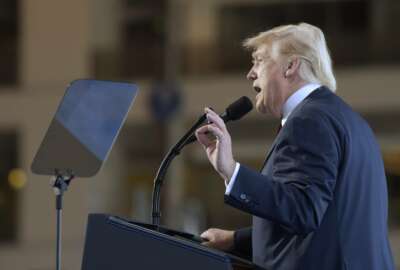
Prospect of sequestration isn’t the only reason the House minibus has little chance of survival
The House passed a "minibus" of 2018 spending bills before leaving town for a month-long recess. Budget experts say the possibility of sequestration isn't the only...
With two months left until the end of the fiscal year, the House took its first significant step in advancing the appropriations process last week, setting up a messy budget showdown in September.
Lawmakers passed the Make America Secure Appropriations Act, a “minibus” of spending bills that sets appropriations for the departments of Defense, Energy, Interior, Veterans Affairs and other agencies, as well as the legislative branch.
But the bill, which members rushed to pass before leaving town for a month-long recess, sets topline figures that exceed the spending caps set in the Budget Control Act of 2011.
The House’s version of the 2018 National Defense Authorization Act, which the chamber cleared last month, also exceeds budget caps.
The House minibus includes $658 billion in total funding for the Defense Department, which includes $584 billion in discretionary spending and nearly $74 billion toward the Overseas Contingency Operations fund. The 2018 minibus appropriates DoD at $68 billion higher than 2017 enacted levels.
“If the House minibus became law, it would in fact trigger a sequester,” said David Berteau, CEO of the Professional Services Council. “That sequestration would be pretty substantial. In the case of the Defense Department, we’re looking at a 13 percent, across the board cut for every account in DoD. For comparison purposes, that’s almost double the sequester impact of the only time we’ve had a big sequester which was back in the spring of 2013.”
The possibility of sequestration isn’t the only reason the House minibus has little chance of survival, budget experts said.
Passing the House minibus will be a difficult — if not nearly impossible — sell in the Senate, which needs 60 votes and Democratic support to move forward.
And Senate Democrats won’t agree to a budget resolution that includes big boosts to defense spending without some kind of increase in civilian spending.
“Yes, the president wants to cut domestic appropriations dramatically and put that money into defense, but they don’t have the votes for that,” said Steve Bell, a senior adviser with the Bipartisan Policy Center. “It just simply isn’t there.”
Plus, House and Senate appropriators have been hesitant to buy into the administration’s budget proposal.
“You have seen in every subcommittee hearing, in every subcommittee markup, the Congress is not aligning itself with the administration’s cuts,” Berteau said.
The White House, though it ultimately said it supported the House minibus and was pleased to see high defense investments, called for more “fiscally responsible reductions to spending elsewhere in the federal budget.”
“[House lawmakers] had a chance to get their message out,” Bell said. “It’s important to differentiate between really doing something and messaging. Now they’ve messaged. They’re very strong on defense. They’re not strong on domestic. Nobody really wants to say that out loud yet, but those bills have virtually no chance of ever becoming law.”
Even if the House minibus has a small chance of Senate passage, senators aren’t entirely opposed to higher defense spending, Berteau said.
“There’s general agreement, widespread, bipartisan agreement, that defense needs more money,” Berteau said. “There’s general agreement that we ought to appropriate more for defense, and the appropriations bills and the authorization bills in the House and the Senate reflect this. There’s not agreement on how to fit that increase in defense into the Budget Control Act caps or into a budget resolution.”
That agreement may be elusive, or at least, difficult to come by, especially under Congress’ tight timeline over the next two months. And an agreement that satisfies Senate Democrats won’t satisfy the Trump administration, which called for offsets to defense spending through deep cuts to civilian spending in the president’s 2018 budget request.
Both Bell and Berteau believe lawmakers ultimately won’t appropriate above the sequester cap levels, at least without agreeing to raise or repeal them.
Latest Budget News
“We’ll know the answer by the end of December, and I think the answer is going to be increases in defense and non-defense that will make neither Democrats nor Republicans entirely happy,” Berteau said. “But there will be … either a repeal or substantial increases in the sequester caps.”
No member of Congress has yet issued a written proposal calling for the higher budget caps or a repeal of them altogether.
And neither Bell nor Berteau predicts Congress will pass a continuing resolution through November or December. There’s simply not enough time, they say, for lawmakers to reach an agreement when they return from recess after Labor Day.
“It’s almost inevitable that we’ll start the fiscal year under a continuing resolution, although it is possible that we could have a government shutdown,” Berteau said. “What we’ve been telling our member companies is, it’s not likely that the government will shut down on Oct. 1, but it is prudent for the companies to prepare and for contractors to be helping their government customers prepare for that possibility as well.”
Continuing resolution
A continuing resolution for the first few months of fiscal 2018 would create a few problems for agencies — and their contractors — as well. Whatever the topline numbers, spending levels in fiscal 2017 vastly differ from the suggested numbers in the president’s 2018 budget proposal.
“You get a disconnect even under a continuing resolution,” Berteau said. “It’s probably OK for the agencies who are going to have deep cuts; they’ll be happy. But the agencies that need the increases won’t get them; they’ll be unhappy.”
A CR for the first few months of fiscal 2018 and beyond may mirror the situation agencies faced in fiscal 2017.
Depending on how long a CR lasts, agencies would likely have to scramble, as many are doing already this year, to adjust their operations and spending to comply with the topline numbers included in the 2018 budget resolution — whenever that comes.
Many agencies are already doing that now. A CR for the first seven months of fiscal 2017 is prompting agencies in the fourth quarter to spend at a rate that’s 50 percent higher than the spending rate from previous quarters, Berteau said.
Debt ceiling
Both Bell and Berteau predict the debt ceiling will play a significant role in Congress’ budget negotiations.
Treasury Secretary Steve Mnuchin told congressional leadership he expects the government won’t be able to pay all of its bills on or around Sept. 29 and urged lawmakers to raise Treasury’s borrowing authority.
With the timing of the debt ceiling and the end of the fiscal year only one day apart, Berteau said he he could see a scenario that ties debt ceiling extensions to a decision on fiscal 2018 spending.
“It’s not hard to craft a solution that not only makes sense, but that’s good for all the parties involved,” Berteau said. “The question is who’s leading the way to get to that resolution, and right now, it’s hard to see that.”
Copyright © 2025 Federal News Network. All rights reserved. This website is not intended for users located within the European Economic Area.
Nicole Ogrysko is a reporter for Federal News Network focusing on the federal workforce and federal pay and benefits.
Follow @nogryskoWFED






